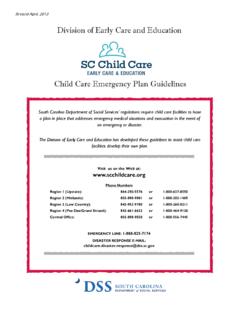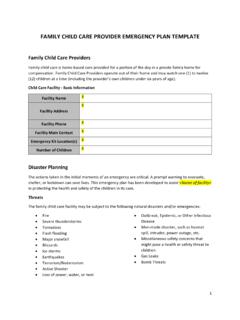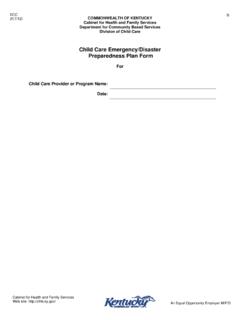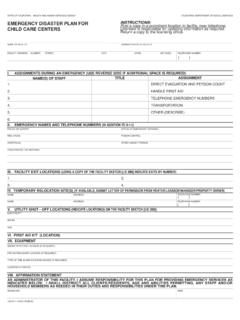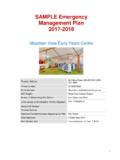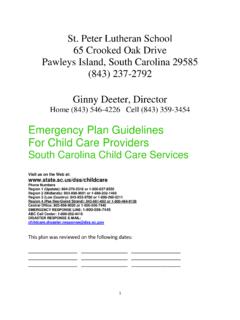Transcription of A GENCY RESPONSE ANNING GUIDE FOR CHILD …
1 INDIANAEMERGENCYRESPONSEPLANNINGGUIDEFOR CHILD CAREPROVIDERSRESPONSEINDIANAEMERGENCYPLA NNINGGUIDEFORCHILD CAREPROVIDERSThis page is intentionally left OF INDIANAOPEN LETTER TO THE CHILD care PROVIDER INDUSTRYCONCERNINGEMERGENCY PREPAREDNESS PLANNINGThe Indiana Department of Homeland Security and the Family and Social Services Administration, Bureau of CHILD care and other partner agencies have collaborated to provide the Indiana emergency RESPONSE Planning GUIDE for CHILD care preparation and involvement of CHILD care staff, parents, and the community can directly affect the outcome of an emergency . This GUIDE identifies the hazards common to Indiana and offers practical information on how to prepare your CHILD care program for emergency situations. Further, the GUIDE offers examples from other organizations and input from subject matter experts to equip you with the tools needed to develop plans for emergency GUIDE provides basic preparedness and planning information for use in a variety of CHILD care settings.
2 The information can be tailored to meet the needs of your facility and you should consult with key representatives within your area to ensure compliance with state and federal effort has been made to provide accurate, up-to-date information. New hazards can emerge and procedures change over time, so emergency preparedness information is in constant development. CHILD care providers should routinely update plans and, if necessary, seek additional appreciate the time and efforts you use every day to ensure the children of Indiana are cared for in a safe and secure you for all that you H. Hill, Executive Director Michael A. Gargano, SecretaryIndiana Department of Homeland Security Family and Social Services Administration4 Indiana emergency RESPONSE Planning GUIDE for CHILD care ProvidersVersion TABLE OF CONTENTSA cknowledgements ..6 Background ..7 Purpose ..7 Scope ..8 Information From the Threat and Hazard Index Risk Assessment.
3 8 Reducing the Potential Threat of Emergencies ..11 Illness Prevention ..12 emergency Action Plans (EAP) ..13 Lockdown ..14 Shelter-in-Place ..14 Temporary Evacuation ..14 Permanent Evacuation and Off-Site Sheltering ..15 CHILD care Program Planning Considerations ..15 Fire ..15 Severe Weather ..15 Flash Flood/Flood .. Disruption ..18 Physical or Verbal Threats ..18 Potentially Violent Situations (Intruder/Hostage Situation) ..19 Missing or Abducted CHILD ..20 Hazardous Material (In the facility) ..21 Hazardous Material Spill (Outside facility) ..215 Roles and Responsibilities of Supplies ..22 Evacuation ..23 Transportation ..23 Communication of emergency Action plan ..23 Reunification ..23 emergency Drills and Procedures ..24 GUIDE on Handling Medical Illness Emergencies and Disease Outbreaks ..24 Special Considerations for Children With Health care Needs ..25 Recovering From an emergency ..25 Staff Training Resources.
4 26 Resources ..26 References ..27 Tab 1: emergency or Temporary Closure List of Conditions ..28 Tab 2: Suggested Roles and Responsibilities Checklist ..29 Tab 3: Ready-to-Go emergency Kit Supply List ..31 Tab 4: First Aid Kit Supply List ..32 Tab 5: Communicable Disease Symptoms Chart ..33 Forms ..35 Form 1: emergency Information ..36 Form 2: emergency Contact List ..37 Form 3: Parent Contact Card ..39 Form 4: emergency Consent Form ..40 Form 5: emergency Information for Parents ..41 Form 6: Parent Wallet Cards ..42 Form 7: Transportation Authorization ..43 Form 8: Children With Special Health care Needs ..446 ACKNOWLEDGEMENTS Indiana Association for CHILD care Resource and Referral Indiana Department of Education, Indiana School Safety Specialist Academy Indiana Department of Environmental Management, Community Environmental Health and Education Indiana Department of Homeland Security, Planning and Assessment Division Indiana Family & Social Services Administration, Bureau of CHILD care Indiana School of Medicine, emergency Medical Services for Children Indiana State Department of Health, Public Health Preparedness and emergency RESPONSE Indiana State Fire Marshal s Office7 BACKGROUNDI ndiana has more than 4,500 CHILD care facilities serving over 100,000 Hoosier children.
5 For these children, their parents, and facility staff, it is imperative to be prepared if disaster strikes. Recent events show programs with a well developed and regularly practiced emergency plan are better able to protect lives and return to normal operation in a shorter time period. In recent years, Indiana CHILD care providers have experienced emergencies and disasters including floods, fires, ice storms, tornadoes, extreme weather conditions, and hazardous material spills either within the CHILD care facility or in the vicinity of the facility. In the event of an emergency , the CHILD care facility may close temporarily, and may evacuate and relocate children to an alternate location. In such emergencies, children may or may not understand what is happening, or may be physically or developmentally unable to rescue or protect term facility used throughout this GUIDE refers to any location (center, ministry or home) that cares for children, is non-medical, and is for less than 24 GUIDE provides basic preparedness and planning information to enhance the safety of children and staff in any CHILD care setting.
6 CHILD care providers may use this GUIDE as a planning tool as it also includes forms and additional resources. Forms may be reproduced as needed. Plans should be easily understood rather than complex with multiple steps, which staff, parents, and town offi-cials will not be able implement when faced with an emergency situation. The five goals of the GUIDE are to educate providers in developing an emergency RESPONSE plan in the following areas:1. Creating and executing an emergency evacuation Collecting and posting emergency Reviewing and posting guides on how to handle an emergency within the CHILD care Training staff on specific roles and responsibilities during an Reviewing special considerations for children with health needs and disabilities during an GUIDE outlines the roles and responsibilities of the Incident Command System (ICS), which is also part of the National Incident Management System (NIMS).
7 NIMS provides an efficient, practi-cal approach that helps GUIDE departments and agencies at all levels of government, nongovernmen-tal organizations, and the private sector to work seamlessly to prevent, protect against, respond to, recover from and mitigate the effects of incidents regardless of cause, size, location, or complexity in order to reduce the loss of life and property and harm to the environment. ICS provides a chain of command and lays out the roles and responsibilities during an emergency . 8 SCOPEThis planning GUIDE allows Indiana CHILD care facility managers to be better prepared and continue to provide care for children in a safe and effective environment during emergency conditions. Information in this GUIDE supplements and is consistent with state statutes, laws, and regulations. It applies to a provider s preparation for emergencies regardless of type of CHILD care facility, , center, ministry or home.
8 This GUIDE should be part of an overall comprehensive emergency preparedness planning and train-ing program. While every disaster cannot be described in this document, CHILD care providers are encouraged to incorporate information in this GUIDE to meet the specific needs of their respective organization or business during any emergency that may FROM THE THREAT AND HAZARD INDEX RISK ASSESSMENTThe Indiana Department of Homeland Security (IDHS) has identified threats and hazard risks for the State of Indiana in the 2010 Hazard Identification and Risk Assessment. This comprehensive study was completed in 2010 and surveys the most common incidents that pose a risk to the state. The hazards are categorized by natural, man-made and technological threats and hazard risks are based on a study of disasters and other emergencies in Indiana. Below is a description of each threat and hazard risk which provides suggested planning consider-ations for each one to help GUIDE a facility director in the decision-making Severe Thunderstorma.
9 Description: A severe thunderstorm is a term designating a thunderstorm that has reached a predetermined level of severity. Often, this level is determined by the storm being strong enough to inflict wind or hail damage. According to the National Weather Service, a storm is considered severe if winds reach more than 58 miles per hour and hail is one inch in diameter or larger. b. Planning Considerations: Severe thunderstorms can produce heavy rain, damag-ing straight-line winds, large hail, cloud to ground lightning, and tornadoes. These storms can cause significant damage over a large geographical area. Lightning is responsible for many fires as well as causing deaths when people are struck. Under the right conditions, rainfall from thunderstorms can cause flash flooding, which can change small creeks into raging torrents in a matter of minutes, washing away large boulders and most man-made structures.
10 Hail up to the size of softballs damage cars and windows, and kill wildlife caught out in the open. Strong (up to more than 120 mph) straight-line winds associated with thunderstorms can knock down trees and power lines. 92. Tornadoa. Description: A tornado is a funnel shaped, rapidly rotating column of air that passes in a narrow path over land. The size of a tornado can range from a few yards wide to a mile across. Tornadoes can strike with little or no warning. The average forward speed of a tornado is 30 mph, but may vary from stationary to 70 mph. Winds within the funnel can reach 300 mph. Tornadoes are rated according to the Enhanced Fujita Scale, which mea-sures the amount of damage a tornado causes. Tornadoes are rated from EF-0 to EF-5. EF-0 tornadoes cause only minor damage and have winds up to 85 mph. An EF-5 tornado can cause catastrophic damage with winds greater than 200 mph. Approximately 95 percent of all tornadoes in the United States are EF-2 intensity or below.






